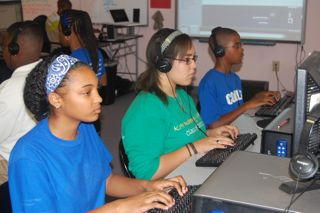We, as adults, use google all the time to find out anything and everything we want. Need to find some resources fast? Google it. Trying to put a face to a name? Google it (thanks Google image!). Hoping to dig up more information about a prospective teacher? Google them. Trying to solve a friendly argument with a friend? Google it. (Beware on this one… I first learned about wikis back in college, and was fooled by someone who went in and changed wikipedia first…)
So what exactly are we teaching our students about what their ‘Google Profile’ is beginning to look like?
I know in my classroom the approach I’ve taken is the less we put out there, the better our profile is. But a recent blog post on ‘Web-blogged’ started to make me question that approach. As a result of such easily accessable information, it unfortunately is taking a more prominent role in hiring (and firing) in today’s workforce. It’s also becoming common for college admissions to ‘Google’ prospective students, and check out their Internet footprint.
In traditional college and job applications, everyone must submit a resume. Even if yours isn’t as good as you would like, you do your best and submit it anyways. I see, and hear, all the time at my school the reinforcement of doing things now that will build a stronger resume later. So instead of just encouraging students to not create an Internet presence at all (or atleast a traceable one), why don’t we explicitly teach them how to create a positive internet presence.
Encourage students to create electronic portfolios with their best, published work. Interested in photography? Introduce them to Flickr and the world that awaits both in terms of inspiration, but also in terms of authentic audience (a huge community is developing around photos on Flickr, with in depth conversations developing around single photographs). Introduce them to VoiceThread where they can create their own voice-guided slideshows and discussions.
What I’m seeing here are three possible outcomes in 4-8 years when a college admissions counselor googles one our kids:
1) They find some embarrassing pictures and potentially crude conversations/posts on MySpace walls, all convincing them to NOT accept our student.
2) They find nothing, leaving them with just the student’s paper (or online) application, resume and GPA.
3) In addition to the student’s application, resume and GPA, they find several year’s worth of published writing, a blog with their (hopefully) insightful thoughts/comments on a variety of topics, published photography and potentially so much more.
So let’s revisit our mission for one second. 100% of our students will attend the college of their choice. It seems to me, if it is becoming popular for college admissions counselors to ‘Google’ potential students, we need to do what we can to make our kids ‘Googleable’, so they’re using every tool they can to become a successful candidate. However, like everything we do, this must be explicitly taught, and not just hoped for. We can’t just give our kids the tools (the Internet, blogs, social networks) without teaching them how to use them and be successful at it. Without that direct instruction, we are finding that we almost inevitably end up with outcome 1.
So where is it being taught now?

